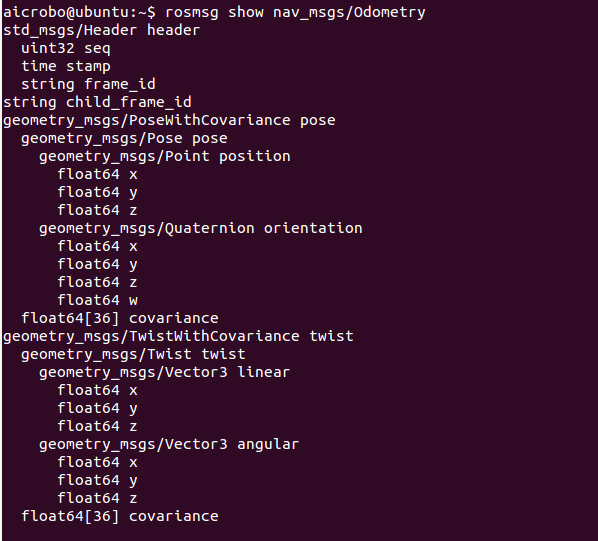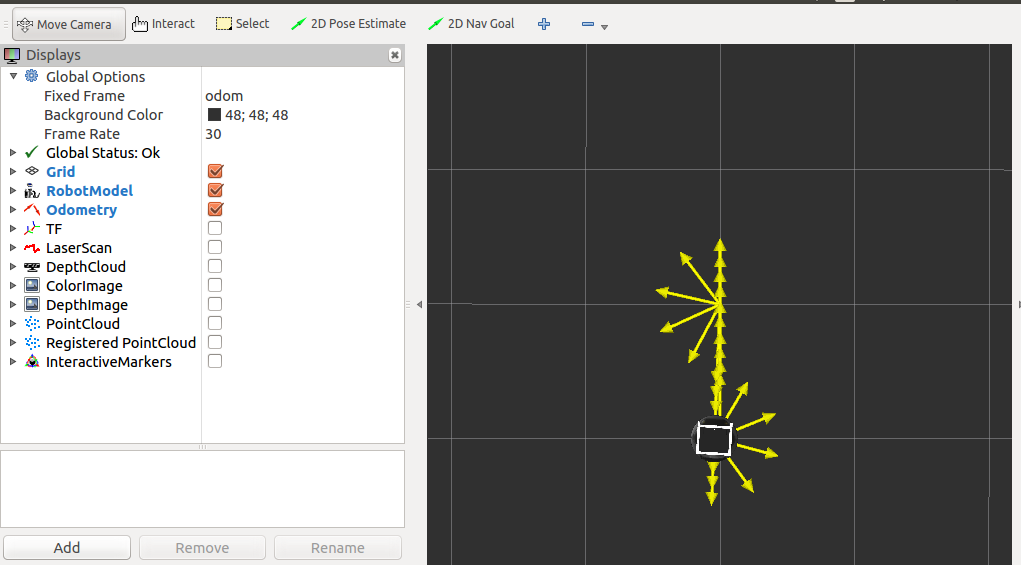系统版本:Ubuntu14.04,ROS indigo
机器人底盘:kobuki
摄像头:Asus Xtion
编程语言:C++
参考书本:ROS by Example
一、功能介绍
使机器人直行1米,接着旋转180°,再返回到起始点。
二、实现方法
根据/odom和/base_footprint(或/base_link)坐标之间的转换来监视机器人的位置和方向。
此方法使用术语“里程信息”(“Odometry”)表示内部位置数据,ROS提供一种消息类型来存储这些信息,既是“nav_msgs/Odometry”。使用以下指令查看消息的数据结构,见图1。
rosmsg show nav_msgs/Odometry
nav_msgs/Odometry提供了机器人frame_id坐标系到child_id坐标系的相对位置。geometry_msgs/Pose消息提供了机器人的位姿信息,消息geometry_msgs/Twist提供了速度信息。线速度x为正时,机器人向前移动,为负时,机器人向后移动。角速度z为正时,机器人向左转,为负时,机器人向右转。
因为里程Odometry其实就是两个坐标系之间的位移,那么我们就有必要发布两个坐标系之间的坐标变换信息。一般ROS的里程测量使用/odom作为父坐标ID(固定坐标),/base_footprint(或/base_link)作为子坐标ID(机器人自身)。这些变换是指机器人相对/odom坐标移动。
三、实验步骤
1.在robot_move/src/里创建odom_out_and_back.cpp,并粘贴如下代码:
#include <ros/ros.h>
#include <signal.h>
#include <geometry_msgs/Twist.h>
#include <tf/transform_listener.h>
#include <nav_msgs/Odometry.h>
#include <string.h>
ros::Publisher cmdVelPub;
void shutdown(int sig)
{
cmdVelPub.publish(geometry_msgs::Twist());
ROS_INFO("odom_out_and_back.cpp ended!");
ros::shutdown();
}
int main(int argc, char** argv)
{
//How fast will we update the robot's movement?
double rate = 20;
int count = 0;//Loop through the two legs of the trip
ros::init(argc, argv, "go_and_back");
std::string topic = "/cmd_vel";
ros::NodeHandle node;
cmdVelPub = node.advertise<geometry_msgs::Twist>(topic, 1);
//Set the equivalent ROS rate variable
ros::Rate loopRate(rate);
geometry_msgs::Twist speed; // 控制信号载体 Twist message
signal(SIGINT, shutdown);
ROS_INFO("odom_out_and_back.cpp start...");
//Set the forward linear speed to 0.2 meters per second
float linear_speed = 0.2;
//Set the travel distance to 1.0 meters
float goal_distance = 1.0;
//Set the rotation speed to 0.5 radians per second
float angular_speed = 0.5;
//Set the rotation angle to Pi radians (180 degrees)
double goal_angle = M_PI;
//Set the angular tolerance in degrees converted to radians
double angular_tolerance = 2.5*M_PI/180; //角度转换成弧度:deg*PI/180
tf::TransformListener listener;
tf::StampedTransform transform;
//Find out if the robot uses /base_link or /base_footprint
std::string odom_frame = "/odom";
std::string base_frame;
try
{
listener.waitForTransform(odom_frame, "/base_footprint", ros::Time(), ros::Duration(2.0) );
base_frame = "/base_footprint";
ROS_INFO("base_frame = /base_footprint");
}
catch (tf::TransformException & ex)
{
try
{
listener.waitForTransform(odom_frame, "/base_link", ros::Time(), ros::Duration(2.0) );
base_frame = "/base_link";
ROS_INFO("base_frame = /base_link");
}
catch (tf::TransformException ex)
{
ROS_INFO("Cannot find transform between /odom and /base_link or /base_footprint");
cmdVelPub.publish(geometry_msgs::Twist());
ros::shutdown();
}
}
//Loop once for each leg of the trip
for(int i = 0;i < 2;i++)
{
ROS_INFO("go straight...!");
speed.linear.x = linear_speed; // 设置线速度,正为前进,负为后退
//Get the starting position values
listener.lookupTransform(odom_frame, base_frame, ros::Time(0), transform);
float x_start = transform.getOrigin().x();
float y_start = transform.getOrigin().y();
// Keep track of the distance traveled
float distance = 0;
while( (distance < goal_distance) && (ros::ok()) )
{
//Publish the Twist message and sleep 1 cycle
cmdVelPub.publish(speed);
loopRate.sleep();
listener.lookupTransform(odom_frame, base_frame, ros::Time(0), transform);
//Get the current position
float x = transform.getOrigin().x();
float y = transform.getOrigin().y();
//Compute the Euclidean distance from the start
distance = sqrt(pow((x - x_start), 2) + pow((y - y_start), 2));
}
//Stop the robot before the rotation
cmdVelPub.publish(geometry_msgs::Twist());
ros::Duration(1).sleep(); // sleep for a second
ROS_INFO("rotation...!");
//Now rotate left roughly 180 degrees
speed.linear.x = 0;
//Set the angular speed
speed.angular.z = angular_speed; // 设置角速度,正为左转,负为右转
//yaw是围绕Y轴旋转,也叫偏航角
//Track the last angle measured
double last_angle = fabs(tf::getYaw(transform.getRotation()));
//Track how far we have turned
double turn_angle = 0;
while( (fabs(turn_angle + angular_tolerance) < M_PI) && (ros::ok()) )
{
//Publish the Twist message and sleep 1 cycle
cmdVelPub.publish(speed);
loopRate.sleep();
// Get the current rotation
listener.lookupTransform(odom_frame, base_frame, ros::Time(0), transform);
//C++: abs()求得是正数的绝对值,fabs()求得是浮点数的绝对值;python:abs(x),参数可以是:负数、正数、浮点数或者长整形
double rotation = fabs(tf::getYaw(transform.getRotation()));
//Compute the amount of rotation since the last loop
double delta_angle = fabs(rotation - last_angle);
//Add to the running total
turn_angle += delta_angle;
last_angle = rotation;
}
//Stop the robot before the rotation
//Set the angular speed
speed.angular.z = 0;
cmdVelPub.publish(geometry_msgs::Twist());
ros::Duration(1).sleep(); // sleep for a second
}
cmdVelPub.publish(geometry_msgs::Twist());
ros::Duration(1).sleep(); // sleep for a second
ROS_INFO("odom_out_and_back.cpp ended!");
ros::shutdown();
return 0;
}
特别说明:代码中的注释大部分引用《ros_by_example_indigo_volume_1》这本书的,英文注释简单易懂,所以不作翻译了。
2.修改robot_move目录下的CMakeLists.txt
在CMakeLists.txt文件末尾加入几条语句:
add_executable(odom_out_and_back src/odom_out_and_back.cpp)
target_link_libraries(odom_out_and_back ${catkin_LIBRARIES})3.编译程序
在catkin_ws目录下,进行catkin_make编译,得到odom_out_and_back执行程序。
4.测试程序
4.1 启动roscore
roscore4.2 启动机器人
4.2.1若是运行仿真机器人
roslaunch aicroboxi_bringup fake_aicroboxi.launch4.2.2若是运行真实的机器人平台
roslaunch aicroboxi_bringup minimal.launch4.3 启动 rviz 图形化显示程序
roslaunch aicroboxi_rviz view_mobile.launch4.4 启动odom_out_and_back程序,效果如图2
rosrun robot_move odom_out_and_back
四、解释部分代码
tf::TransformListener listener;
tf::StampedTransform transform;
//Find out if the robot uses /base_link or /base_footprint
std::string odom_frame = "/odom";
std::string base_frame;
try
{
listener.waitForTransform(odom_frame, "/base_footprint", ros::Time(), ros::Duration(2.0) );
base_frame = "/base_footprint";
ROS_INFO("base_frame = /base_footprint");
}
catch (tf::TransformException & ex)
{
try
{
listener.waitForTransform(odom_frame, "/base_link", ros::Time(), ros::Duration(2.0) );
base_frame = "/base_link";
ROS_INFO("base_frame = /base_link");
}
catch (tf::TransformException ex)
{
ROS_INFO("Cannot find transform between /odom and /base_link or /base_footprint");
cmdVelPub.publish(geometry_msgs::Twist());
ros::shutdown();
}
}
创建StampedTransform对象来获取变换信息,创建TransformListener对象监听坐标变换。我们需要/odom坐标和/base_footprint坐标或者/base_link坐标之间的变换。首先测试是否存在/base_footprint坐标,如果不存在,再测试/base_link坐标。结果将保存在base_frame变量,以便之后使用。在本次实验使用的是/base_footprint坐标。
//Loop once for each leg of the trip
for(int i = 0;i < 2;i++)
{
ROS_INFO("go straight...!");
speed.linear.x = linear_speed; // 设置线速度,正为前进,负为后退
//Get the starting position values
listener.lookupTransform(odom_frame, base_frame, ros::Time(0), transform);
float x_start = transform.getOrigin().x();
float y_start = transform.getOrigin().y();
执行两次循环,每次循环都是机器人移动直行1米,然后旋转180°。每次循环一开始,我们都记录起始点的位置。使用listener对象来查看odom_frame和base_frame坐标的变换,并记录在transform。通过transform.getOrigin().x()和transform.getOrigin().y()获得起始点位置。
float distance = 0;
while( (distance < goal_distance) && (ros::ok()) )
{
//Publish the Twist message and sleep 1 cycle
cmdVelPub.publish(speed);
loopRate.sleep();
listener.lookupTransform(odom_frame, base_frame, ros::Time(0), transform);
//Get the current position
float x = transform.getOrigin().x();
float y = transform.getOrigin().y();
//Compute the Euclidean distance from the start
distance = sqrt(pow((x - x_start), 2) + pow((y - y_start), 2));
}
这个循环是使机器人直行1米。
while( (fabs(turn_angle + angular_tolerance) < M_PI) && (ros::ok()) )
{
//Publish the Twist message and sleep 1 cycle
cmdVelPub.publish(speed);
loopRate.sleep();
// Get the current rotation
listener.lookupTransform(odom_frame, base_frame, ros::Time(0), transform);
//C++: abs()求得是正数的绝对值,fabs()求得是浮点数的绝对值;python:abs(x),参数可以是:负数、正数、浮点数或者长整形
double rotation = fabs(tf::getYaw(transform.getRotation()));
//Compute the amount of rotation since the last loop
double delta_angle = fabs(rotation - last_angle);
//Add to the running total
turn_angle += delta_angle;
last_angle = rotation;
}
这个循环使机器人在一定angular_tolerance角度误差内旋转180°。abs()求得是正数的绝对值,fabs()求得是浮点数的绝对值。tf::getYaw(transform.getRotation())获取旋转的角度。
五、使用Odometry行走一个正方形
设置四个导航点,使机器人移动成一个正方形。效果如图3.

源代码地址:https://github.com/KeoChi/robot_move
个人学习笔记,欢迎交流学习。